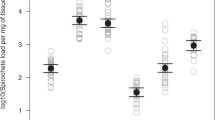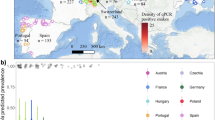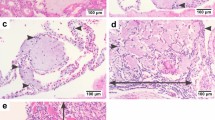Abstract
Dutch elm disease was first recorded in 1918 in Western Europe and quickly spread to the US. The origin of the causal fungus, Ceratocystis ulmi, is unknown. A serious new epidemic began in the UK around 1970 and led to the discovery that there were two strains of the fungus: a highly pathogenic ‘aggressive strain’ responsible for the epidemic and thought to have been imported from North America1,2, and a less pathogenic ‘non-aggressive strain’ believed to be endemic to the UK and adjacent parts of Europe since the 1920s (refs 1, 2). Recent disease outbreaks associated with the appearance of the aggressive strain in Holland3 (1972), France4,5 and Germany6,7 (1973) were assumed to be secondary foci of the UK epidemic. A similar outbreak in Italy7 (1973), however, seemed to be of longer standing (L. Mittemberger and O. Rackham, personal communications) and this, together with the discovery of the aggressive strain in Iran in 1975 (ref. 8), suggested that there was more than one source of the aggressive strain. I show here that there are two distinct races of the aggressive strain and that they have probably entered Europe independently.
This is a preview of subscription content, access via your institution
Access options
Subscribe to this journal
Receive 51 print issues and online access
$199.00 per year
only $3.90 per issue
Buy this article
- Purchase on Springer Link
- Instant access to full article PDF
Prices may be subject to local taxes which are calculated during checkout
Similar content being viewed by others
References
Gibbs, J. N. & Brasier, C. M. Nature 241, 381–383 (1973).
Brasier, C. M. & Gibbs, J. N. Nature 242, 607–609 (1973).
Gremmen, J., Heybroek, H. H. & de Kam, M. Ned. BoschbTijdschr. 48, 137–143 (1976).
Pinon, J. La Recherche 4, 700–701 (1973).
Pinon, J. Phytoma 5–8 (1978).
Maschning, E. Allg. Forstz 29, 306–308 (1974).
Brasier, C. M. & Gibbs, J. N. in Proc. 1973 IUFRO Conference on Dutch elm disease, Minneapolis 53–66 (USDA Forest Service, 1975).
Brasier, C. M. & Afsharpour, F. Eur. J. For. Path. 9, 113–122 (1979).
Brasier, C. M. Trans Br. mycol. Soc. 68, 45–52 (1977).
Brasier, C. M. & Gibbs, J. N. Nature 257, 128–131 (1975).
Walsh, P. F. & Mangan, A. J. Dep. Agric. Repub. Ire. 74, 40–43 (1977).
Brasier, C. M. & Gibbs, J. N. Ann. appl. Biol. 80, 231–235 (1975).
Author information
Authors and Affiliations
Rights and permissions
About this article
Cite this article
Brasier, C. Dual origin of recent Dutch elm disease outbreaks in Europe. Nature 281, 78–80 (1979). https://doi.org/10.1038/281078a0
Received:
Accepted:
Published:
Issue Date:
DOI: https://doi.org/10.1038/281078a0
This article is cited by
-
Comparison of a recent elm decline with the mid-Holocene Elm Decline
Vegetation History and Archaeobotany (2019)
-
Biosynthesis, Microstructural Characterisations and Investigation of In-Vitro Mutagenic and Eco-Toxicological Response of a Novel Microbial Exopolysaccharide Based Biopolymer
Journal of Polymers and the Environment (2018)
-
The plasticity of fungal interactions
Mycological Progress (2017)
-
Sap flow-based quantitative indication of progression of Dutch elm disease after inoculation with Ophiostoma novo-ulmi
Trees (2014)
-
Long-term vegetation dynamics in the Šumava Mts. natural spruce-fir-beech forests
Plant Ecology (2008)
Comments
By submitting a comment you agree to abide by our Terms and Community Guidelines. If you find something abusive or that does not comply with our terms or guidelines please flag it as inappropriate.



